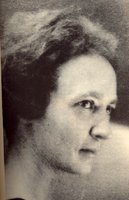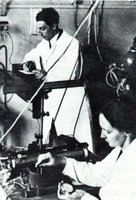Joliot-Curie, Irène

| Topics: |
Irène Joliot-Curie (1897–1956), born in Paris, France, September 12, 1897, was the daughter of Pierre and Marie. As a child, she had the unusual experience of attending for two years a special school that emphasized science, organized by her mother, Marie Curie, and Marie’s scientific friends for their own children. Joliot-Curie was still a teenager when she worked with her mother in the radiography corps during World War I. After the war, Joliot-Curie assisted her mother at the Radium Institute in Paris, meanwhile completing her doctorate. She became Doctor of Science in 1925, having prepared a thesis on the alpha rays of polonium. She married Frédéric Joliot, a young physicist who had come to work with her mother.
Either alone or in collaboration with her husband, she did important work on natural and artificial radioactivity, transmutation of elements, and nuclear physics. The Joliot-Curies won the Nobel Prize for chemistry in 1935 for their discovery of artificial radiation by bombardment of alpha particles (helium nuclei, He2+) on various light elements. They correctly interpreted the continued positron emission that occurred after bombardment had ceased as evidence that "radioactive isotopes" of known elements had been created. These isotopes rapidly became important tools in biomedical research and in the treatment of cancer.

In 1938, Joliot-Curie's research on the action of neutrons on the heavy elements, was an important step in the discovery of uranium fission. Appointed lecturer in 1932, she became Professor in the Faculty of Science in Paris in 1937, and afterwards Director of the Radium Institute in 1946. Being a Commissioner for Atomic Energy for six years, Joliot-Curie took part in its creation and in the construction of the first French atomic pile in 1948. She was concerned in the inauguration of the large center for nuclear physics at Orsay for which she worked out the plans. This center was equipped with a synchro-cyclotron of 160 MeV, and its construction was continued after her death by her husband.
Joliot-Curie took a keen interest in the social and intellectual advancement of women; she was a member of the Comité National de l'Union des Femmes Françaises and of the World Peace Council. In 1936 she was appointed Undersecretary of State for Scientific Research. She was a member of several foreign academies and of numerous scientific societies, had honorary doctor's degrees of several universities, and was an Officer of the Legion of Honour. She died in Paris in 1956.
The Joliot-Curies were the parents of a boy, Pierre, and a girl, Helene, both of whom became scientists—thus continuing a famous scientific dynasty.
Further Reading